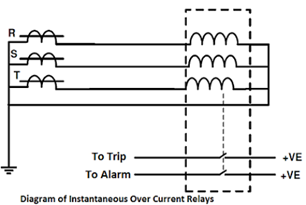
Types of Overcurrent Relays
Overcurrent protection uses amperage relays because it responds as soon as the amperage rise exceeds certain setting values. There are four types of overcurrent relays.
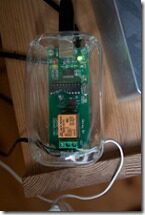
1. Instantaneous overcurrent relay
2. Time-definite overcurrent relay
3. Inverse time overcurrent relay
4. Directional overcurrent relay
Instantaneous overcurrent relay
An instantaneous overcurrent relay is a type of overcurrent protection device that operates without any intended delay. It is designed to immediately trip or activate its protection function when the current exceeds a predetermined set point.
The main characteristic of an overcurrent relay is its quick response to overcurrent conditions. When the current exceeds the set point, the relay detects this fault and sends a trip signal to the circuit breaker or associated protective device. This immediate response helps to quickly isolate the faulty section of the electrical system, minimizing potential equipment damage and shortening the duration of the failure. 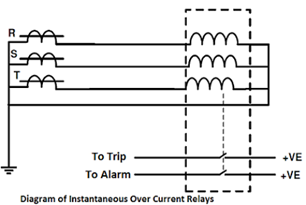
The operating criterion for overcurrent relays with immediate effect is the current intensity (no delay). This type is applied to substation output feeders. The fast overcurrent relay assignment diagram is shown above.
Instantaneous overcurrent relays are typically used when quick and decisive response to overcurrent events is required. They are widely used in electrical distribution systems for short circuit protection, motor overload protection and branch line protection. These relays are particularly useful in critical systems where even a momentary overcurrent can have serious consequences.
A key advantage of the overcurrent relay is its simplicity. Its functionality is based on a simple comparison between the current intensity and the specified setpoint. The relay is activated when the current exceeds the set point, initiating the protective action. This hassle-free functionality makes the relay reliable, robust and suitable for various electrical systems.
Definite time overcurrent relay
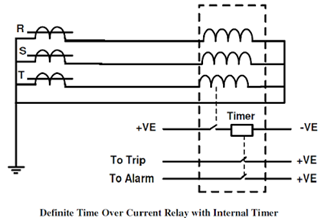
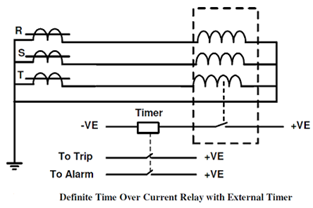
The independent time overcurrent relay is the most commonly used form of overcurrent protection. It is used as:
Cable distance relay backup protection with time delay capable of fourth stage of distance relay, which is 2.5 seconds for 220 kV lines and 1.5 seconds for 66 kV lines.
Backup protection for the power transformer differential relay with a delay of 2.0 seconds for 220/66 kV transformers and 1.1 seconds for 66/11 kV transformers.
Main reinforcement for feeders and bus couplings with adjustable control delay time.
Inverse Time Overcurrent Relay
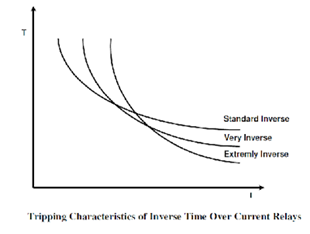
Normal inverse
The Inverse Normal characteristic is the simplest form of the inverse time curve used in overcurrent relays. It follows a curved shape where the delay gradually decreases as the current increases. The relatively smooth curve shows a proportional relationship between current and time. The Inverse Normal characteristic is suitable for general applications that require moderate coordination and selectivity.
Very reverse
The very inverse characteristic provides a more pronounced inverse relationship between current and time than the normal inverse function. The curve has a steeper slope at lower current levels, indicating faster tripping at higher fault currents. This specific type is useful for applications where a faster response to higher fault currents is desired, while ensuring coordination for smaller magnitude faults.
Extremely reverse
The extreme inverse characteristic represents a more aggressive response to overcurrent conditions. The curve shows a rapid decrease in delay with increasing current. It offers a highly selective response and trips quickly even with moderate fault currents. The extremely inverse characteristic is suitable for systems that require a high degree of discrimination and rapid error elimination.
Directional overcurrent relay
A directional overcurrent relay is a special overcurrent protection device that monitors the strength and direction of current in the electrical power system. It is primarily used in applications where sensing the direction of current flow is critical for proper operation and protection.
The main function of a directional overcurrent relay is to identify fault conditions that occur in a specific direction of current flow, such as a feeder or transmission line with multiple sources or feeders. Taking into account the current trend, the relay can selectively trip or initiate protective measures only for faults that occur in the desired order, while ignoring faults in other laws.
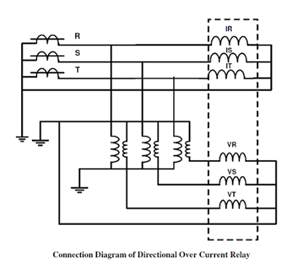
The directional overcurrent relay is connected to the current relay, which acts in the direction of current flow and blocks in the other direction. Three conditions must be met for operation. The two previous conditions, current and time delay, must be taken into account; therefore, radial asymmetry is the twenty-third additional condition in this species. Radial asymmetry of current flow is called incorrect manipulation of voltage as a directional reference. The connection diagram of the current and voltage circuits of directional overcurrent relays. Almost this type is installed at the bottom of the power transformer.

